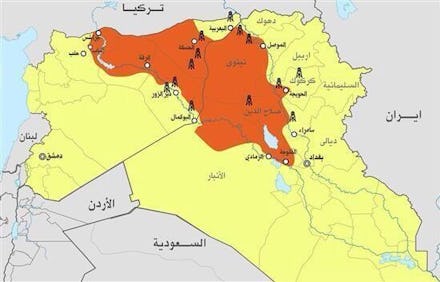To Understand the Crisis in Iraq, Follow the Pipelines

The news: Terrorist group Islamic State in Iraq and Syria (ISIS), the world's richest terrorist group, now controls large portions of both Iraq and Syria. Even though al-Qaida ended formal association with the Islamic extremists in February, they've grown large enough to seize areas with particularly lucrative oil resources. By transporting and selling oil to and throughout their regime, ISIS is becoming even wealthier and expanding their power.
The faction's agenda includes money, armed forces, religion and, now increasingly, oil. And it's that last one that poses the largest threat in taking down the Syrian government and creating the proto state they want.
Aaron Zelin, an analyst with the Washington Institute for Near East Policy, recently discovered a 2006 map where ISIS projected their potential control.
Image Credit: Aaron Y. Zelin
To get a clearer understanding of the region, this current map illustrates where attacks have occurred and shows the controlled provinces in detail.
Image Credit: The Economist
By comparing the two, ISIS starts to look like a fine-tuned group with the ability to achieve their ambitious goals. They plotted out regions to control in Syria and northern Iraq with oil in mind.
The New York Times reported that so far ISIS has taken over oilfields in Syria and resumed pumping. On Wednesday, forces gained control of Iraq's largest oil refinery and power plant, Baiji. Even worse, the insurgents have "secured revenue by selling electricity to the government from captured power plants."
In January the Telegraph reported that ISIS was being financed "by selling oil and gas from wells under their control to and through the regime," proving that they've taken very deliberate steps in securing power.
What will the money be used for? Essentially, power. But after robbing Mosul's central bank on Wednesday and walking away with $425 million, you have to wonder why ISIS needs more money.
The insurgents want the money to pay their members. And the group is attracting more members by paying higher salaries. This is in addition to the group's already luring qualities such as extremist ideology, highly skilled armed forces and an ability to consolidate power. So they are bringing in more man-power and paying them much better than the Iraq and Syrian armies, who have seen high a number of deserters recently.
What does this all mean? ISIS has been carving out stringent parameters since the beginning of the year. Their first set of new rules impose strict standards on the occupied territory: No guns, alcohol or cigarettes will be allowed, women must dress modestly and all Muslims are to pray on time.
In a rough count, ISIS only has 7,000 troops, far smaller than the Iraq army's 250,000 troops, not including armed police forces. While the Islamic group does have U.S.-supplied humvees and weaponry, despite many commentators' fears, they don't have the manpower likely needed to seize Baghdad. But even without Baghdad, the group's premeditated tactics have already given them the huge advantage of being able to maintain enough capital to sustain its growing members.
It is still unclear if ISIS will be able to operate and run all of the Syrian and Iraqi oilfields down the line. Though their strategic vision is telling enough about how they operate — enough to worry the rest of the world anyway.